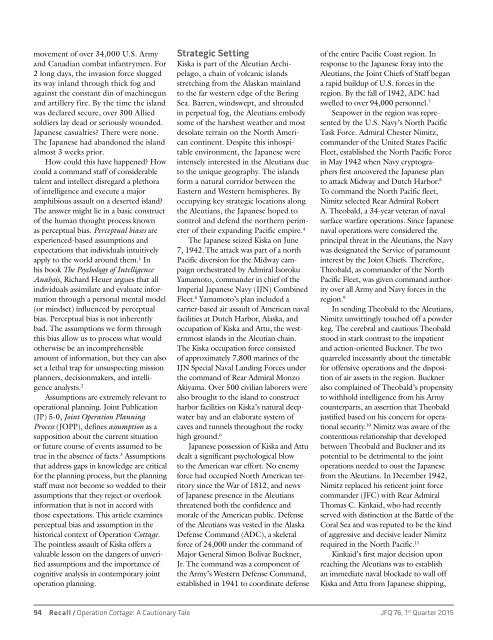jfq-76
jfq-76
jfq-76
Create successful ePaper yourself
Turn your PDF publications into a flip-book with our unique Google optimized e-Paper software.
movement of over 34,000 U.S. Army<br />
and Canadian combat infantrymen. For<br />
2 long days, the invasion force slugged<br />
its way inland through thick fog and<br />
against the constant din of machinegun<br />
and artillery fire. By the time the island<br />
was declared secure, over 300 Allied<br />
soldiers lay dead or seriously wounded.<br />
Japanese casualties? There were none.<br />
The Japanese had abandoned the island<br />
almost 3 weeks prior.<br />
How could this have happened? How<br />
could a command staff of considerable<br />
talent and intellect disregard a plethora<br />
of intelligence and execute a major<br />
amphibious assault on a deserted island?<br />
The answer might lie in a basic construct<br />
of the human thought process known<br />
as perceptual bias. Perceptual biases are<br />
experienced-based assumptions and<br />
expectations that individuals intuitively<br />
apply to the world around them. 1 In<br />
his book The Psychology of Intelligence<br />
Analysis, Richard Heuer argues that all<br />
individuals assimilate and evaluate information<br />
through a personal mental model<br />
(or mindset) influenced by perceptual<br />
bias. Perceptual bias is not inherently<br />
bad. The assumptions we form through<br />
this bias allow us to process what would<br />
otherwise be an incomprehensible<br />
amount of information, but they can also<br />
set a lethal trap for unsuspecting mission<br />
planners, decisionmakers, and intelligence<br />
analysts. 2<br />
Assumptions are extremely relevant to<br />
operational planning. Joint Publication<br />
(JP) 5-0, Joint Operation Planning<br />
Process (JOPP), defines assumption as a<br />
supposition about the current situation<br />
or future course of events assumed to be<br />
true in the absence of facts. 3 Assumptions<br />
that address gaps in knowledge are critical<br />
for the planning process, but the planning<br />
staff must not become so wedded to their<br />
assumptions that they reject or overlook<br />
information that is not in accord with<br />
those expectations. This article examines<br />
perceptual bias and assumption in the<br />
historical context of Operation Cottage.<br />
The pointless assault of Kiska offers a<br />
valuable lesson on the dangers of unverified<br />
assumptions and the importance of<br />
cognitive analysis in contemporary joint<br />
operation planning.<br />
Strategic Setting<br />
Kiska is part of the Aleutian Archipelago,<br />
a chain of volcanic islands<br />
stretching from the Alaskan mainland<br />
to the far western edge of the Bering<br />
Sea. Barren, windswept, and shrouded<br />
in perpetual fog, the Aleutians embody<br />
some of the harshest weather and most<br />
desolate terrain on the North American<br />
continent. Despite this inhospitable<br />
environment, the Japanese were<br />
intensely interested in the Aleutians due<br />
to the unique geography. The islands<br />
form a natural corridor between the<br />
Eastern and Western hemispheres. By<br />
occupying key strategic locations along<br />
the Aleutians, the Japanese hoped to<br />
control and defend the northern perimeter<br />
of their expanding Pacific empire. 4<br />
The Japanese seized Kiska on June<br />
7, 1942. The attack was part of a north<br />
Pacific diversion for the Midway campaign<br />
orchestrated by Admiral Isoroku<br />
Yamamoto, commander in chief of the<br />
Imperial Japanese Navy (IJN) Combined<br />
Fleet. 5 Yamamoto’s plan included a<br />
carrier-based air assault of American naval<br />
facilities at Dutch Harbor, Alaska, and<br />
occupation of Kiska and Attu, the westernmost<br />
islands in the Aleutian chain.<br />
The Kiska occupation force consisted<br />
of approximately 7,800 marines of the<br />
IJN Special Naval Landing Forces under<br />
the command of Rear Admiral Monzo<br />
Akiyama. Over 500 civilian laborers were<br />
also brought to the island to construct<br />
harbor facilities on Kiska’s natural deepwater<br />
bay and an elaborate system of<br />
caves and tunnels throughout the rocky<br />
high ground. 6<br />
Japanese possession of Kiska and Attu<br />
dealt a significant psychological blow<br />
to the American war effort. No enemy<br />
force had occupied North American territory<br />
since the War of 1812, and news<br />
of Japanese presence in the Aleutians<br />
threatened both the confidence and<br />
morale of the American public. Defense<br />
of the Aleutians was vested in the Alaska<br />
Defense Command (ADC), a skeletal<br />
force of 24,000 under the command of<br />
Major General Simon Bolivar Buckner,<br />
Jr. The command was a component of<br />
the Army’s Western Defense Command,<br />
established in 1941 to coordinate defense<br />
of the entire Pacific Coast region. In<br />
response to the Japanese foray into the<br />
Aleutians, the Joint Chiefs of Staff began<br />
a rapid buildup of U.S. forces in the<br />
region. By the fall of 1942, ADC had<br />
swelled to over 94,000 personnel. 7<br />
Seapower in the region was represented<br />
by the U.S. Navy’s North Pacific<br />
Task Force. Admiral Chester Nimitz,<br />
commander of the United States Pacific<br />
Fleet, established the North Pacific Force<br />
in May 1942 when Navy cryptographers<br />
first uncovered the Japanese plan<br />
to attack Midway and Dutch Harbor. 8<br />
To command the North Pacific fleet,<br />
Nimitz selected Rear Admiral Robert<br />
A. Theobald, a 34-year veteran of naval<br />
surface warfare operations. Since Japanese<br />
naval operations were considered the<br />
principal threat in the Aleutians, the Navy<br />
was designated the Service of paramount<br />
interest by the Joint Chiefs. Therefore,<br />
Theobald, as commander of the North<br />
Pacific Fleet, was given command authority<br />
over all Army and Navy forces in the<br />
region. 9<br />
In sending Theobald to the Aleutians,<br />
Nimitz unwittingly touched off a powder<br />
keg. The cerebral and cautious Theobald<br />
stood in stark contrast to the impatient<br />
and action-oriented Buckner. The two<br />
quarreled incessantly about the timetable<br />
for offensive operations and the disposition<br />
of air assets in the region. Buckner<br />
also complained of Theobald’s propensity<br />
to withhold intelligence from his Army<br />
counterparts, an assertion that Theobald<br />
justified based on his concern for operational<br />
security. 10 Nimitz was aware of the<br />
contentious relationship that developed<br />
between Theobald and Buckner and its<br />
potential to be detrimental to the joint<br />
operations needed to oust the Japanese<br />
from the Aleutians. In December 1942,<br />
Nimitz replaced his reticent joint force<br />
commander (JFC) with Rear Admiral<br />
Thomas C. Kinkaid, who had recently<br />
served with distinction at the Battle of the<br />
Coral Sea and was reputed to be the kind<br />
of aggressive and decisive leader Nimitz<br />
required in the North Pacific. 11<br />
Kinkaid’s first major decision upon<br />
reaching the Aleutians was to establish<br />
an immediate naval blockade to wall off<br />
Kiska and Attu from Japanese shipping,<br />
94 Recall / Operation Cottage: A Cautionary Tale JFQ <strong>76</strong>, 1 st Quarter 2015




